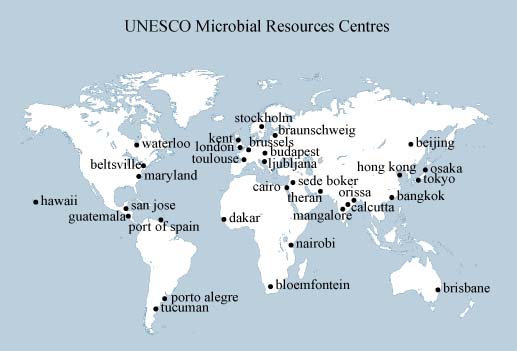
Edition 8 - November, 2000
 Edition 8 - November, 2000 |
The MIRCEN network: a global resource for international co-operation |
![]() he management and sustainable
exploitation of culture collections requires time and personnel. At the world
level and especially in developing countries, there is a shortage of funds,
conservation facilities, and skilled people for the ex situ conservation and
study of microbial genetic resources. Culture collections can improve and accomplish
their mission only by means of equitable and judicious networking. There is
no way forward without such co-operation. Therefore, the BCCM promotes focused
collaboration on a long-term basis between well-established collections and
promising but not yet secured collections. Such co-operation often evolves into
long-term equitable partnerships.
he management and sustainable
exploitation of culture collections requires time and personnel. At the world
level and especially in developing countries, there is a shortage of funds,
conservation facilities, and skilled people for the ex situ conservation and
study of microbial genetic resources. Culture collections can improve and accomplish
their mission only by means of equitable and judicious networking. There is
no way forward without such co-operation. Therefore, the BCCM promotes focused
collaboration on a long-term basis between well-established collections and
promising but not yet secured collections. Such co-operation often evolves into
long-term equitable partnerships.
At the consortium level, the BCCM collections have seen the improvement of their capacity of conservation, handling and study of microbial resources through collaborative efforts and managerial co-ordination. At the international level, for BCCM, co-operation means involvement as a consortium as well as through its individual collections in international networking activities such as the UNESCO Network of Microbial Resources Centres (MIRCEN).
 |
Today, MIRCEN is a global network that is building bridges between more than 30 academic and research institutes in both developed and developing countries. These centres, in co-operation with the national commissions of member states and governmental authorities, are participating in a collaborative effort to develop the sustainable use of the microbial world for the benefit and well-being of humankind through international scientific co-operation. The object of such international co-operation is to enhance the internationalisation of new development strategies. These strategies must be adapted to the imperatives of economic and technological development; funding and cost-sharing responsibilities have to be determined; the infrastructure and the academic environment have to be developed; and the quality of these efforts has to be enhanced.
The MIRCEN programme has come a long way, since UNESCO's early efforts to establish microbial resources centres in developing countries. As early as 1946, UNESCO’s set out to strengthen several threatened treasure houses of microbial diversity. UNESCO also provided catalytic support to the categorisation and inventory of the planet's microbial genetic resources in the two decades preceding the UN Conference on the Environment in 1972, Stockholm, Sweden.
The period of 1975-1984 saw active collaboration with the United Nations Environment Programme (UNEP) in the establishment of MIRCENs in Bangkok, Brisbane, Cairo, Dakar, Guatemala, Nairobi, Porto Alegre, and Stockholm. Similar collaboration with the United Nations Development Programme (UNDP) between 1987 and 1993 saw the emergence of the European network with MIRCENS in Budapest and Ljubljana. Again, co-operation with UNDP in West Asia (1989-1994) and in the Caribbean (1989-1994) resulted in the development of MIRCENS in Tehran and Port of Spain.
Other MIRCENs in Argentina, Canada, China, France, Germany, Hong Kong, India, South Africa, the UK and the USA were established within the framework of UNESCO's Regular and Participation Programmes in co-operation with the UNESCO National Commissions.
The MIRCEN Networks in Africa have been strengthened considerably. This has been possible through active collaboration with UNDP during the period from 1988 to 1994 and the continuing support provided by the Food and Agricultural Organisation (FAO) to MIRCENS in Africa – as in Latin America – through direct assistance to research projects and the supply of equipment for inoculum production. The catalytic actions of the MIRCENS in Nairobi, Dakar, and to some extent in Cairo, with the supply of technical equipment to institutes in Kenya, Mali, Senegal, and South Africa, have proved useful in the production of biofertilisers.
In this new millennium, there is a growing hope that the global MIRCEN network will become a tool to promote the sustainable use of microbial resources, using bioinformatics to intensify the flow of knowledge and data between developed and developing countries. The MIRCEN network should also become a forum for tackling essential issues of access to microbial resources and related technology, of benefit-sharing, and of intellectual property. The BCCM consortium, functioning as a key MIRCEN, is playing its part in these developments.
Home |
Contents Edition 8 - November, 2000 |
Next Article Edition 8 - November, 2000 |